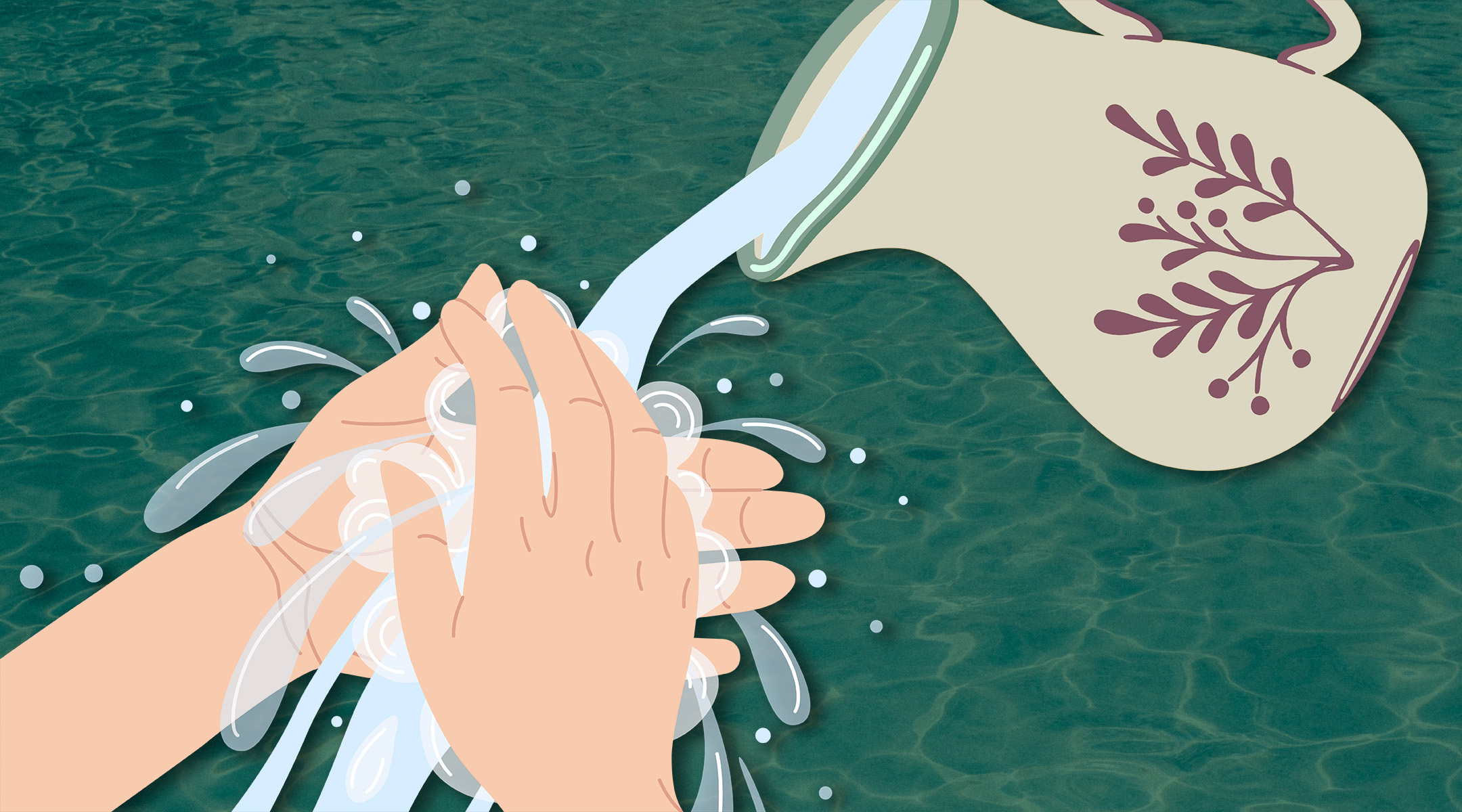(JTA) — At the height of the pandemic, I remember maddeningly washing, scrubbing and antibacterial-spritzing my hands in a bathroom along the New Jersey Turnpike. I then Olympic speed-walked to my car and rubbed my hands down again with a disinfecting wipe.
In those days of social distancing, the basic Jewish ritual of handwashing before meals — tossing water three times over each hand from a communal pitcher — felt to me like an extremely low standard of cleanliness.
You may know the ritual, even if you don’t do it regularly: It’s the second step at the Passover seder, right after the blessing of the wine and just before you dip the parsley in salt water, when guests line up at the sink or someone passes a bowl of water and a towel around the table.
The rest of the year, the Jewish hand-washing ritual is usually associated with substantial meals (at minimum, a meal that includes bread). During the height of the pandemic, I was rarely sitting down for meals — at least not breakfast or lunch — because most of my daylight hours were in Zoom-land and most of what I was consuming was microwaved leftovers. This left me feeling disconnected on multiple levels. Me and millions of other people.
I needed to find ways to reconnect. I started taking more meetings on the phone and I decided that I would try to slow down and eat lunch with a little more mindfulness — even if I was just making myself a peanut butter and jelly sandwich. And that is when I reluctantly rediscovered ritual handwashing.
At first, I stood at our kitchen sink and tried to reconnect to the simplicity of the act — just slowing down and breathing as I poured water over my hands from a vessel. I knew that the ancient origins of ritual washing take us back to the practice of one kohen (priest) washing the feet and hands of another kohen before engaging in the work of the sacrifices. I started to think of this act as some form of sacred self-care where my left hand was caring for my right and vice versa. I started to make a habit of washing my hands with a vessel and I started to read more about the ritual.
One element of the washing is called “shifshuf yadayim,” which literally means “rubbing the hands,” and is initially described in the Tosefta (Yadaim 1:2), a 2nd-century CE compilation of Torah law. In an 18th-century text, Pri Megadim, there is a teaching that the rubbing is done so that the water touches every part of skin on the back and front of the hands and in the nooks between the fingers. This led me to become more mindful of the ways that rubbing brings your consciousness to the contours of your hands and to the act of caring for your hands. Rabbi Shneur Zalman of Liadi (1745-1812) taught that when the rubbing is done with intention, it helps you to obtain a “tahara yeteira” — an extra level of purity.
I slowed down even more. I started using the minimal amount of water, turning my hand gently as I poured the water, and focusing on the sensation of the water covering the entire surface of the hands. In doing so I felt more connected to water’s miraculous power to cleanse and to refresh. And as I did this again and again, it became more than just a conscious moment of self-care and connection to water — it was as if I were awakening the deadened nerves in my hands and healing from the psychic wounds of those many months of lockdown and general fear of others. Through this gentle cleaning and attention to my hands I was experiencing a rebirth and a return — two themes that take us to the present moment.
In the Brenner home, we are frantically zipping about preparing to host the extended clan for Passover, a massive Tetris game of rearranging furniture, shlepping folding tables from the basement and cramming just enough chairs for three generations to sit together in a charming old house in New Jersey that sadly lacks “flow.”
Having guests find their way out of this maze and parade through the kitchen to wash is not feasible. Still, I want to share my newfound love for handwashing, so I will be passing out small cups with 3.2 ounces of water (the minimum amount required) so that everyone can fully engage with that often overlooked second ritual of the seder, known as urchatz. I even went so far as to work with an artist, Helene Brenenson, to design a guide to handwashing that includes a series of wellbeing-centered teachings to accompany the four essential steps of the ritual: lifting the vessel, pouring the water, rubbing the hands together and lifting the hands.
As I worked on this guide, I had a minor epiphany: Giving this water ritual, urchatz, a prominent spot at the seder was a brilliant rabbinic move. The Passover story begins with a drought (lack of water) that brought the Israelites to Egypt, ends with the miraculous crossing of a sea (walls of water), and eventually leads us to a land described in Deuteronomy as having “streams of water, of springs and underground water bursting forth from valley and mountain.” Urchatz connects us to the water imagery of the Passover seder and both physically and spiritually prepares our hands to take hold of the parsley (or other vegetable) and taste the “Spring” that symbolizes this time of rebirth.
Now I look back on those months of frantic pandemic handwashing and feel gratitude. My disconnection not only helped me seek out new ways to approach a basic pre-eating ritual, but led me to appreciate something that was always right there in the seder but I had never truly bothered to appreciate. This year the number two ritual in the seder’s order is number one in my heart.
is the Vice President of Education for Moving Traditions and is grateful to the leaders and fellows of the M2 Jewish Pedagogies of Wellbeing Fellowship for supporting the research that led to this teaching.
The views and opinions expressed in this article are those of the author and do not necessarily reflect the views of JTA or its parent company, 70 Faces Media.




